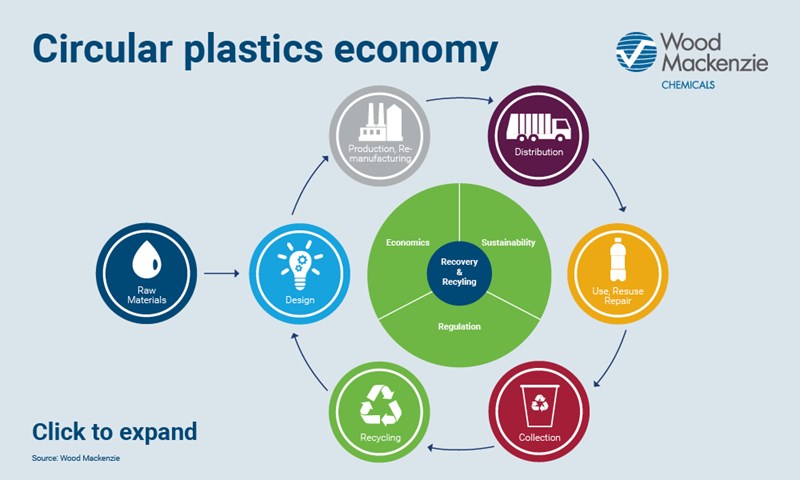1 minute read
The oil industry is turning to petrochemicals for long term growth as vehicle efficiencies and electrification render transportation a declining market. Of course, petrochemicals often means 'plastics' and with the sustainability spotlight shining brightly on this area, what impact will environmental strategies to reduce or ban plastic consumption have on long-term oil demand growth?
The problem with plastic
Resolving this complex and increasingly sensitive issue will be challenging. The starting point to understanding the implications for natural resources and the environmental consequences of shifting away from plastics must be: if not plastic – what? And reviewing the entire supply chain is essential otherwise the issue of environmental impact will simply surface elsewhere.
Plastics are favoured by many because they are incredibly efficient and cost effective but finding alternative solutions for their many uses is going to be complicated, problematic and expensive requiring a commitment from the public, brand owners and governments. This will take time.
A circular plastics economy could lessen the impact of disposal while having minimal impact on chemical demand growth due to rising incomes, populations and living standards. It is important to note that waste management is a major problem, primarily in developing countries, and better management would go a long way in addressing plastics waste in the oceans and the negative public perception. So although the rate of growth (in percentage terms) will be lower than we've seen, it's still growth stemming from an ever expanding base so the volumes are quite sizeable.
of total oil demand will come from the petrochemical sector by 2035
Ethane will capture the majority of this, and, along with naphtha, will remain the primary feedstock for petrochemicals and plastics. And the chemical industry will continue to grow requiring continuous investment. By 2035 chemicals will account for almost all oil demand growth. Approaching 2040 our forecast shows chemicals being almost 20% of total oil demand.
Intentions and implementation are not aligned
Much of the negativity around plastics is focused on one time use applications. Governments, retailers, brand owners and environmental groups have stated their intentions to reduce plastics waste derived from packaging and single-use items. And evidence of such intentions are being put into practice, from the proliferation of re-usable water bottles to out right bans on plastic bags. All this with the goal of reducing use while creating a circular plastics economy.
If we look at food packaging a complex story emerges. Plastics helps prevent spoilage which leads to reduced transportation and food costs plus lower energy requirements. Equally, moving away from plastic packaging can lead to increased spoilage and therefore more land, water, pesticides, equipment and so on being consumed. Examining the entire chain is essential to fully understanding the impact of removing plastics from the equation.
If not plastic, what?
Over half of all everyday plastics are consumed in non-durable applications. Paper is often suggested as a replacement for plastic, for example with drinking straws or coffee cups. Yet paper has a greater carbon impact than plastic. On top of this, there's a problem with recycling film backed paper such as those in paper coffee cups. Cardboard, wood and metal are options but in most applications are not a viable alternative. To help highlight this notion, in Europe plastics account for half of all packaging yet account for less than 20 percent of packaging materials by weight. The solution to the plastics problem won't be a quick fix.
The waste hierarchy
When it comes to addressing the problem of waste, reducing it is the first option. This started happening about 10 years ago with rising oil prices pushing up the cost of plastics raw materials. Packaging started to become thinner as a way of reducing the amount of plastics used. However, as we see with PET water bottles, if packaging becomes too light, recycling becomes difficult. So in fact we may see up-gauging of some packaging in the near future, to facilitate recyclability.
Who will foot the bill?
Eventually the consumer and/or brand owners will have to absorb the higher costs associated with replacing the efficient and cost effective plastic solutions currently in place. But these new solutions are not clear cut and it will take time to properly address all aspects of the pollution problem. Until then the populist view that plastics are a problem will likely prevail.
Our insight, A circular plastics economy: long on intentions, short on solutions, addresses the difficulties and complexities of banning plastics. While we advocate recycling and strongly believe it will grow at a very fast pace it is starting from a low and it is also facing hurdles. The insight summarizes the major issues surrounding plastics and the impact it will have on chemical demand growth to 2035 plus the effect it has on oil and chemical feedstock demand. Complete the form to access this insight and learn more about how the evolving circular plastics economy will be instrumental in the next phase of the oil industry's growth.







